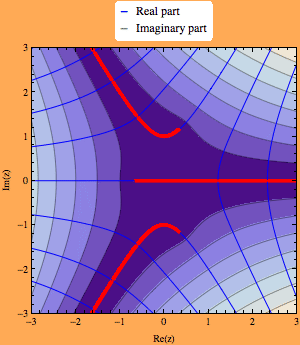I need to compute following contour integrations:
$$f(u)=\oint_\alpha dz \sqrt{z^3+z+u} \qquad ; \qquad g(u)=\oint_\beta dz \sqrt{z^3+z+u}$$
In which $\alpha$ and $\beta$ are two contours in complex $z$-plane determined by
branch points of polynomial under square root. Structure of branch points and cuts are as follows:

For example for $u=0$, there are three roots $\{-i,0,i\}$ and $\alpha$ encircles $\{-i,0\}$ and $\beta$ encircles $\{0,i\}$. So is for other values of $u$ so the contour is dependent on value of $u$.
For numerical integration, and for $f(u)$ we can deform the contours as follows:

And contributions along circles as radius of circles go to zero, vanish and one left with integration along two segments. But integration along bottom segment is exactly as above segment (we circle around a branch point and integrand takes a minus sign):
$$\oint_{\alpha}=2\int_{\text{Upper Segment}}$$
And the same for $g(u)$.
Then I used following code (in this code for $u=0$, $z_1$ corresponds to root $0$,$z_2$ corresponds to root $-i$ and $z_3$ corresponds to root $i$ ):
First Compute roots:
Rs = z /. FullSimplify[Solve[z^3 + z + u == 0, z]];
r[a_][i_] := r[Rs[[i]] /. u -> a]
Then for $f(u)$:
pointlistf =
Table[{u, NIntegrate[Sqrt[z^3 + z + u], {z, r[u][2], r[u][1]}]}, {u, -1.2,
1.2, .01}];
f = Interpolation[pointlistf];
Plot[{Re[f[u]], Im[f[u]]}, {u, -1.2, 1.2}, PlotRange -> All,
PlotStyle -> {{Green, Thickness[0.01]}, {Yellow, Thickness[.01]}}]
Df[u_] := (f[u + a]] - f[u - a])/(2 a) /. a -> 0.000001
Plot[{Re[Da[u]], Im[Da[u]]}, {u, -1.2, 1.2}, PlotRange -> All,
PlotStyle -> {{Green, Thickness[0.01]}, {Yellow, Thickness[.01]}}]
And Similarly for $g(u)$
pointlistg =
Table[{u, NIntegrate[Sqrt[z^3 + z + u], {z, r[u][1], r[u][3]}]}, {u, -1.2,
1.2, .01}];
g = Interpolation[pointlistg];
Plot[{Re[g[u]], Im[g[u]]}, {u, -1.2, 1.2}, PlotRange -> All,
PlotStyle -> {{Green, Thickness[0.01]}, {Yellow, Thickness[.01]}}]
Dg[u_] := (g[u + a]] - g[u - a])/(2 a) /. a -> 0.000001
Plot[{Re[Dg[u]], Im[Dg[u]]}, {u, -1.2, 1.2}, PlotRange -> All,
PlotStyle -> {{Green, Thickness[0.01]}, {Yellow, Thickness[.01]}}]
I have several questions:
- Is my reason for deformation of contour correct?
- Does my code make sense?
- How can I put structure of cuts into Mathematica?
- Is it possible to get an analytic expression for $f(u)$ and $g(u)$ in Mathematica?
- Is it possible to get an analytic expression for $\frac{\partial f(u)}{\partial u}$ and $\frac{\partial g(u)}{\partial u}$ in Mathematica?
- Does Cauchy's Theorem applicable in this case? More precisely does presence of branch points break analyticity of function? or is non-trivial value of this integral related to the fact that these contours can't be contracted in one sheet completely and so Cauchy's Theorem is not applicable?
(Sorry I couldn't add "Hi" at the beginning!)

